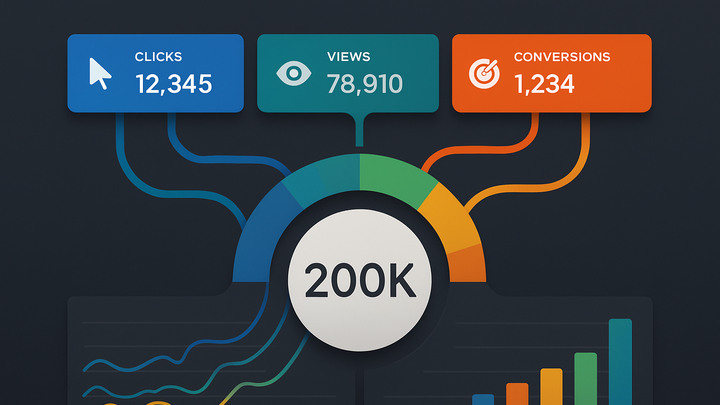Published on 2025-06-22T07:05:03Z
What is a Composite Metric? Examples in Analytics
Composite metrics are calculated measures that merge two or more individual metrics into a single KPI. They provide a holistic view of performance by combining data points such as pageviews, session duration, and conversion rates. For example, you might weight engagement actions and purchase events to create a custom “Value Score.” In Google Analytics 4 (GA4), calculated metrics can be set up in the UI or via BigQuery exports. With PlainSignal’s cookie-free analytics, you can compute composites in your analytics pipeline or client-side code. Composite metrics streamline reporting, reveal hidden trends, and align dashboards with strategic objectives.
Composite metric
Composite metrics combine multiple base measurements into a single custom KPI for deeper, high-level insights.
Core Components of Composite Metrics
This section breaks down the building blocks of composite metrics and why each is important.
-
Base metrics
The raw inputs—such as pageviews, clicks, or conversions—that feed into the composite calculation.
-
Quantitative metrics
Numbers that represent counts or amounts, e.g., total events recorded.
-
Qualitative metrics
Ratios or rates, e.g., engagement rate or bounce rate.
-
-
Aggregation methods
Mathematical operations—like sum, average, ratio, or weighted score—used to combine base metrics.
-
Simple sum/average
Add or average raw counts for a straightforward composite.
-
Weighted scores
Apply different weights to metrics based on business priorities.
-
-
Normalization & scaling
Adjusting metrics to a common scale ensures fair combination across different units.
Why Composite Metrics Matter
Composite metrics offer a high-level lens on performance, enabling quicker insights and alignment with business goals.
-
Holistic performance view
Combine multiple data points into one to understand overall health at a glance.
-
Simplified reporting
Reduce dashboard clutter by tracking a single composite score instead of many individual metrics.
-
Custom kpis
Tailor composites to reflect unique business objectives or user journeys.
Implementing Composite Metrics in GA4 and PlainSignal
How to define and calculate composite metrics in leading analytics tools: Google Analytics 4 (GA4) and PlainSignal.
-
GA4 calculated metrics
GA4 allows you to create calculated metrics in the UI or via BigQuery by applying formulas to event parameters.
-
Ui setup
Go to Admin > Custom Definitions > Create Metric, then enter your formula using available parameters.
-
Bigquery exports
Use SQL to define complex composites on your event_data tables.
-
-
PlainSignal composite computation
Since PlainSignal focuses on simple, cookie-free analytics, composites are typically computed post-collection in your dashboards or scripts.
-
Client-side calculation
Fetch raw metrics via API and apply formulas in JavaScript or Python.
-
Server-side aggregation
Aggregate events in your backend or data warehouse for advanced composites.
-
-
Sample tracking code
Use the following snippet to install PlainSignal and begin collecting base metrics:
-
Code snippet
<link rel="preconnect" href="//eu.plainsignal.com/" crossorigin /> <script defer data-do="yourwebsitedomain.com" data-id="0GQV1xmtzQQ" data-api="//eu.plainsignal.com" src="//cdn.plainsignal.com/plainsignal-min.js"></script>
-
Best Practices and Common Pitfalls
Guidance to ensure your composite metrics are reliable, meaningful, and transparent.
-
Ensure data quality
Verify that base metrics are accurate and consistently tracked to avoid misleading composites.
-
Document your formulas
Keep formulas and weighting schemes well-documented for stakeholders to understand how composites are derived.
-
Avoid over-aggregation
Don’t combine too many disparate metrics; ensure the composite remains interpretable and actionable.
